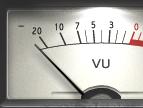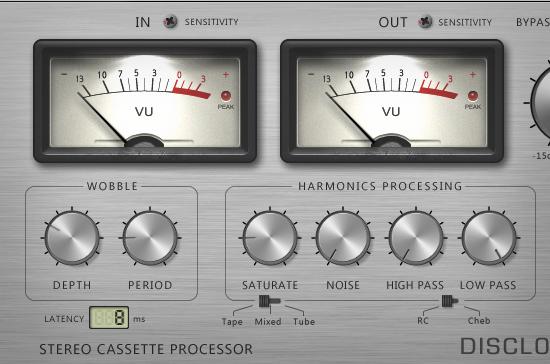
There appears to be quite a lot of interest in something that could be considered retro style these days. A very popular social network Instagram exploited it to a large extent offering so called lo-fi photo filters which are supposed to give photos taken with mobile phones a vintage look which user then can share. The trend does not stop there and everyday web design has also been affected by this interest, where designers resort to use of the 70's looking graphics in their websites.
It was only logical to try to take this trend one step further and create a music player that would imitate the sound of old equipment. Frankly, there has been nothing like that available on the market, be it consumer or professional sound playback and processing software. There is a great number of professional audio plugins that are aimed to imitate old school professional magnetic sound recorders, however their aim was never a characteristic lo-fi destruction of sound but rather adding it a bit of an analogue character.

That is how Tape-o-lizer was created: an attempt to imitate an old tape cassette player sound. The goal was not to do a professional simulation of some particular piece of eqipment but rather give an instantly recognizable effect of an old battered cassette deck. Some considered this attempt to be quite successful. The algorithm of recreation of this style sound did not appear to be that complicated, there are only a handful parameters that one needs to take into account in order to arrive at something convicing. The factors at play are that had to be recreated were:
- Noise and tape hiss
- Stereo channel crosstalk
- High and low frequency filtering
- Tape saturation
- Tape wobble
Noise and tape hiss. Noise is a natural phenomenon that occurs in any sound reproducing equipment, or any equipment, for that matter. If you turn on a speaker set and listen carfully with your ear close to the speaker, you'll hear an amount of hiss that is in this case has been produced by the sound amplifier. If you played a record through the same speakers now, the hiss would not disappear, as might seem first, but rather got masked by the sound signal.
In fact there is more noise present now, the one that originates from original recording equipment and further sound processing. In case of a tape recorder there is another distinct noise source added to the reproduction chain, bein the aforementioned tape hiss. For a record to sound convicing this type of noise has to follow certain spectral parameters, which in our case is resolved by use of filtering.
Stereo channel crosstalk. On a physical tape the stereo tracks are located rather close together, which causes an amount of signal bleeding to happen, where a quiter version of the left channel gets intermixed with the right one, and the other way around. This leads to diminishing of the stereo base, or the difference between the channels, which produces a "narrower" sound. In Tape-o-lizer this effect is achieved by arbitrary amount of mono narrowing of the signal. At 0 the signal is played back as purely mono, and at 100 the signal is passed through unaltered, if the operator does not need the stereo crosstalk to be emulated.
High and low frequency filtering. A characteristic trait of cheap sound reproduction equipment is its alteration of spectrum of the signal that is being played back. Most common ways in which this alteration happens is filtering of the high and low frequencies. In case of tape cassette recorders, the high end is getting filtered due to the low speed of the tape which reduces the available frequency range.
Typically, high speed professional tape machines suffer from from this problem a lot less. Additionally, loss of low frequencies is also quite common for tape cassette recorders due to the small size of the speakers that are similar in performance to nowaday multimedia speakers that often come with PCs, or the ones that are used in TV sets. Tape-o-lizer provides two filtering mode, RC which is an emulation of resistor-capacitor filter which is rather mild, and Chebyshev, a more advanced filter that gives a more drastic filtering effect.
Tape saturation. It should be noted thought that the factors that have been listed above are not something entirely unique to domestic tape recorders, the likes of noise, stereo crosstalk, or frequency filtering are common for many types of playback and recording equipment. What stands tape machines, and especially the cassette tape type ones is the introduction of so called tape saturation. Briefly it could be described as introduction of additional frequencies into the signal due to pecularities of tape recording process.
While in professional tape machines this effect is rather minimal and often not noticeable for many people, for domestically recorded material it is rather common and easy to observe. Its effect is a thicker, louder and somewhat piercing sound that is very easy to recoginze. While there is really only one type of tape saturation that exists, Tape-o-lizer additionally provides two experimental ones:
- Tube, which is an attempt to emulate tube sound of older amplifiers. Its usage not exactly typical in case of cassette tape players.
- Mixed, an additional mode that has not been completed yet and is planned as an additional experimental mode of a saturation type that does not really exist in nature.
Tape-o-lizer naturally addresses this area too. There are two parameters that control this are, wobble period and wobble depth. Both vary from 0 to 100 and while wobble period varies from a quicker and more noticeable cycling to more prolonged and less prominent, the wobble depth controls by how much the record is slowed down, or speeded up. Due to the nature of the effect implemented in digital domain, the wobble depth necessarily creates an amount of delay which may interfere in some cases with other signals mixed in. To address that, there is a latency indicator that specifies the delay that is occuring during wobble depth emulation.
This would cover the basic parameters that this software has in order to emulate the sound of an old cassette tape recorder. At the moment it is not publically available, apart from a beta version released during the beta testing for a short period of time. It is not available at the moment as we need to work out some licensing pecularities, however eventually Tape-o-lizer might be released commercially, or possibly even as freeware. For now we can say that a video reel is being prepared to showcase what the software can actually do, which will be posted here, on Disclosure blog very soon. Stay tuned!



